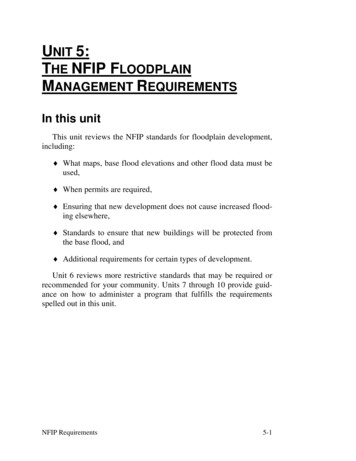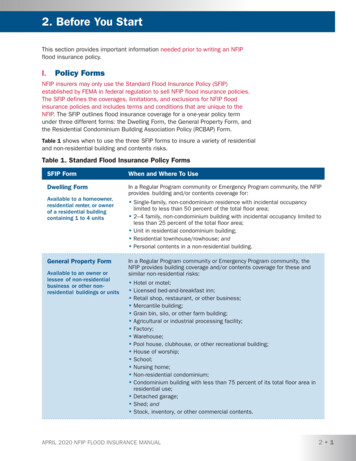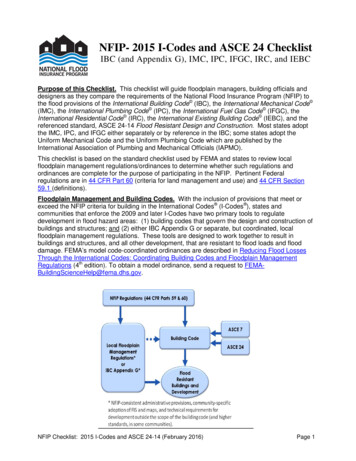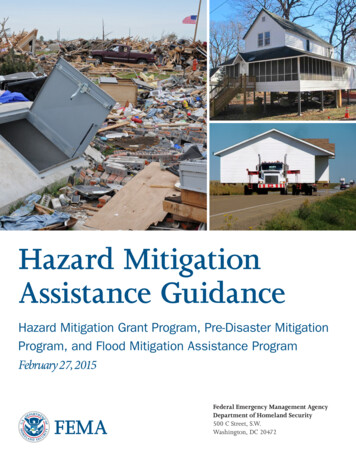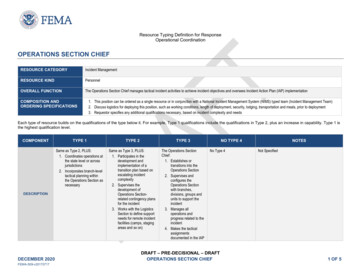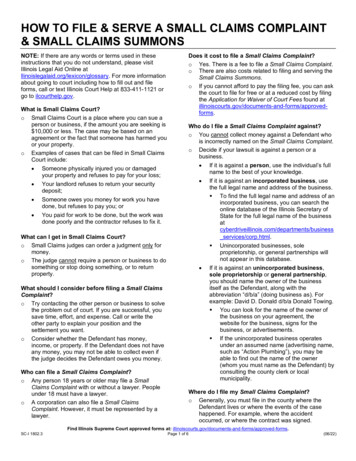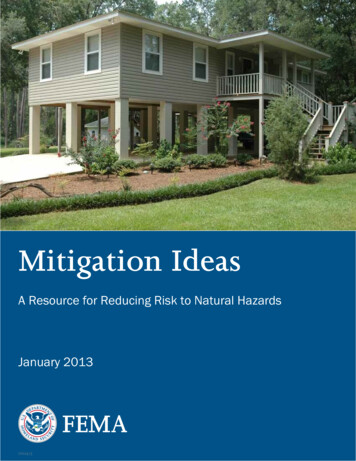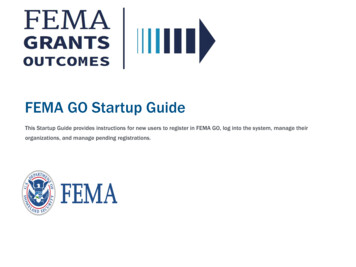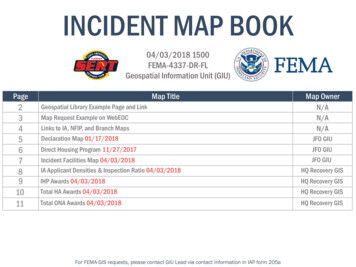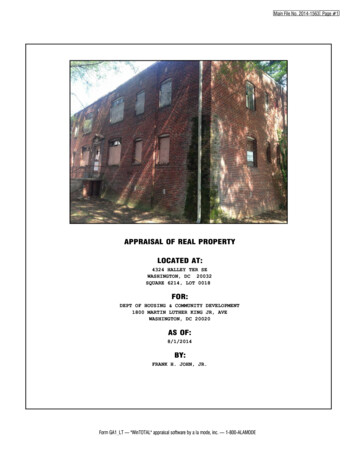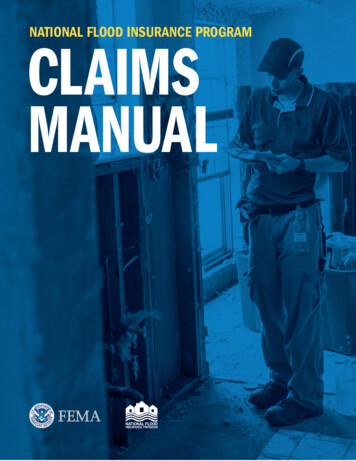
Transcription
FEMA FIMA NFIPClaims ManualTable of ContentsTable of ContentsPurpose . 5Introduction . 7Message to National Flood Insurance Program Claims Professionals . 71National Flood Insurance Program . 82Standard Flood Insurance Policy . 83Emergency and Regular Programs . 94Amounts of Insurance Available . 95Deductibles . 106Group Flood Insurance Policy . 117Disaster Response . 128Claims Professionals Expectations . 14910 NFIP Adjuster Participation . 1611 Examiner Participation in the NFIP . 2012 Training for Claims Professionals. 2313 Federal Insurance and Mitigation Administration Organization Chart. 23Section 1: SFIP Forms . 26Overview . 261Dwelling Form . 272I.Agreement . 27II. Definitions . 28III. Property Covered. 37IV. Property Not Covered . 57V. Exclusions. 63VI. Deductibles . 67VII. General Conditions . 68VIII. Liberalization Clause . 92IX. What Law Governs . 92General Property Form . 943I.Agreement . 94II. Definitions . 95III. Property Covered. 103IV. Property Not Covered . 120V. Exclusions. 125VI. Deductibles . 128VII. General Conditions . 129VIII. Liberalization Clause . 149IX. What Law Governs . 149Residential Condominium Building Association Policy . 1514I.Agreement . 151II. Definitions . 152III. Property Covered. 161IV. Property Not Covered . 177V. Exclusions. 182VI. Deductibles . 186VII. Coinsurance. 187VIII. General Conditions . 189IX. Liberalization Clause . 211X. What Law Governs . 211Section 2: Claims Processes and Guidance . 213Adjuster Preliminary Damage Assessment . 2131Advance Payments . 2132Appraisal . 21732August 30, 2018
FEMA FIMA NFIPClaims ManualTable of 53Claims Adjustment. 217Claims Closed Without Payment Reasons . 220Communications from Attorneys, Public Adjusters, and Other PolicyholderRepresentatives . 221Condominium Claims Handling . 222Contents Manipulation . 223Cooperative Buildings . 224Countertops . 225Debris Removal . 226Electronic Signatures . 227Expense Payments . 227Flood-In-Progress . 228GFIP Claims Handling. 229Guidance on the Use of Outside Professional Services . 229General Adjuster (GA) Re-inspection Request . 231Identification of Building Equipment, Appliances, Electronics, and Mechanicals. 231Improvements and Betterments . 232Increased Cost of Compliance . 233Inspection . 234Letter of Map Amendment/Letter of Map Revision . 235Lowest Elevated Floor Determination. 236Manufactured (Mobile) Home/Travel Trailer Worksheet . 237Non-Waiver Agreement . 238Notice of Loss . 238Overhead and Profit . 238Payment and Paying Undisputed Loss. 239Perimeter Wall Sheathing . 239Photographs . 241Porches . 242Prior Loss Request . 242Prompt Communications . 243Proof of Loss/Increased Cost of Compliance Waiver Request Process . 244Property Address Waiver . 247Property Related to Controlled Substances . 248Release of Claim File Information to Policyholders . 249Remediation, Drying, and Emergency Service Contractors . 250Reporting . 251Requests for Additional Payment . 255Reservation of Rights . 256Salvage . 256SFHAs and Non-SFHAs . 258Special Allocated Loss Adjustment Expense Processes (SALAE) . 258Statute of Limitations . 266Subrogation . 267Underwriting Referral . 268Waiver of Elevated Building Coverage Limitation . 269Wildfires . 270Wind/Flood Loss . 271Withdrawal Letters and Denial Letters. 273Oversight . 273Claim Overpayment Recovery . 276Section 3: Increased Cost of Compliance . 279Increased Cost of Compliance (ICC) . 2791Section 4: NFIP Claims Appeals . 2933August 30, 2018
FEMA FIMA NFIPClaims ManualTable of Contents1NFIP Claims Appeals . 293Appendix . 297Acronyms and Abbreviations . 2994August 30, 2018
FEMA FIMA NFIPClaims ManualPurposeThe purpose of the NFIP Claims Manual is to improve clarity of claims guidance to WYOs, vendors,adjusters, and examiners so that policyholders experience consistency and reliability of service. Themanual provides processes for handling claims from the notice of loss to final payment.All NFIP bulletins, other than those announcing Flood Insurance Claims Office numbers, Flood ResponseOffice locations, claims adjuster briefings, and current/future program changes, are superseded by thismanual and of no further effect.Disclaimer: This document represents the current FEMA guidance on the covered topics and may assistNFIP insurers, adjusters, vendors, and policyholders apply applicable statutory and regulatoryrequirements, as well as the terms and conditions of the Standard Flood Insurance Policy. This documentis not a substitute for applicable legal requirements, nor is it itself a rule. It is not intended to, nor does itimpose, legally-binding requirements on any party, except where parties have voluntarily entered into anagreement requiring compliance with FEMA guidance.FEMA’s discussion of any brand, trademark, or registered mark is not an endorsement.5August 30, 2018
This page was intentionally left blank.6August 30, 2018
FEMA FIMA NFIPClaims ManualIntroductionOver the past several years, the Federal Emergency Management Agency(FEMA) has highlighted our commitment to our policyholders. We aretransforming the ways we manage the National Flood Insurance Program(NFIP). This transformation will enable our partners and stakeholders, WriteYour Own (WYO) insurance companies, insurance company vendors, agents,adjusting firms, adjusters, and examiners as claims professionals, to improveour policyholders’ experience when they have a flood claim.David Maurstad, DeputyAssociate Administrator forInsurance and MitigationWe are getting policyholders on a road to recovery faster through a morerobust advance payment process. We are committed to making our productsand processes easier to understand from the policyholder’s point of view, thatincludes rewriting of our claims and underwriting manuals in plain language soinsurance professionals understand the NFIP and can provide policyholders with consistency andreliability of service.One of FEMA’s strategic goals is to build a culture of preparedness which promotes the idea thateveryone should be prepared when disaster strikes. One way an individual can be prepared is to purchaseproper insurance coverage. As representatives of FEMA and the NFIP, we will treat each policyholder withempathy and respect, ensuring the NFIP adjusts each claim fairly and without unnecessary delay, andhandles each claim as if it were our home or business. Policyholders’ positive word-of-mouth to family,friends, neighbors, and the wider community regarding their claims experience can influence theseindividuals to purchase flood insurance.All of you represent the NFIP and our improved customer experience. You will likely be the first and maybe the only NFIP representative the policyholder engages with after a flood event. FEMA depends on yourcontinued expertise and compassion to help our policyholders recover from what may be a devastatingexperience for them.As a claims professional, you are the one that will guide the policyholders through the entire NFIP claimsprocess – from the notice of loss to their final payment. With your knowledge of the Standard FloodInsurance Policy, you can make the policyholder’s recovery smoother by communicating what they shoulddo to move their claim along the adjustment journey.I would like to take a moment to recognize the hard work you do on our behalf.During the past year, I have had the pleasure of observing quality adjusting by riding along on a numberof loss adjustments. I saw first-hand how much time, effort, and care claims adjusters put into serving ourpolicyholders. It is a tough job entering into dangerous spaces, dealing with conditions such as mold andother hazards, and meeting the needs of NFIP policyholders still processing the toll of a recent flood.I know first-hand how tough this is because my dad was an adjuster. In addition, during my 20 years asan agent, I experienced the challenge of settling property losses many times. I understand the dilemma7August 30, 2018
FEMA FIMA NFIPClaims ManualIntroductionclaims professionals face trying to provide as much assistance to someone in need within the constraintsof the flood insurance contract.We recognize your job is not easy. However, you have the opportunity to affect the claims experiencepositively for NFIP policyholders. I appreciate that you go the extra mile to make sure we are treating ourpolicyholders with integrity and respect and getting every dollar allowed them from the policy theypurchased. Together we can help close the insurance gap and create more resilient communities.The National Flood Insurance Act of 1968 (Title XII of the Housing and Urban Development Act of 1968,Public Law 90-448, codified as amended at 42 U.S.C § 4001 et seq.) created the NFIP. The NFIP is acooperative venture involving the federal government, state and local governments, and the privateinsurance industry. The federal government sets insurance rates, provides the necessary risk studies tocommunities, and establishes floodplain management criteria guiding construction in the floodplain.Communities must adopt and enforce minimum floodplain management standards for new, substantiallyimproved, and substantially damaged structures in order for the NFIP to provide insurance within theirboundaries. Private insurance companies, under an arrangement known as the Write Your Own (WYO)program, sell and service federal flood insurance policies and retain part of the premium for their efforts.FEMA also sells and services federal flood insurance policies through the NFIP Direct Servicing Agent (NFIPDirect).The NFIP offers three Standard Flood Insurance Policy (SFIP) forms – Dwelling Form 1, General PropertyForm 2, and the Residential Condominium Building Association Policy (RCBAP) 3. Each SFIP form has aninsuring agreement between the policyholder and the insurer, which details the terms and conditionsexplaining coverage and non-coverage provisions. 43.1Dwelling FormInsures a single-family dwelling, a two to four family dwelling, a residential renter, or aresidential condominium unit owner. See Section 1 for more information.3.2General Property FormInsures a non-residential building or unit, a residential detached garage or outbuilding, anon-residential leaseholder’s contents, a multi-family dwelling (other residential) such asan apartment building, or a condominium association’s building, which has less than 75percent of its square footage for residential use; and any other building that does notmeet the definition of a Dwelling or RCBAP. See Section 1 for more information.1 44 C.F.R. pt. 61, App. A(1) (2017)2 44 C.F.R. pt. 61, App. A(2) (2017)3 44 C.F.R. pt. 61, App. A(3) (2017)4 See 44 C.F.R. § 61.13 (2017); see also id. pt. 61, App. A(1), A(2), A(3)8August 30, 2018
FEMA FIMA NFIPClaims ManualIntroduction3.3Residential Condominium Building Association Policy (RCBAP)FormInsures a residential condominium building owned by a condominium association, whichhas 75 percent or more of its square footage for residential use. See Section 1 for moreinformation.NFIP only sells flood insurance in communities that participate in the NFIP. See the Community StatusBook for more information.4.1Emergency ProgramA community may initially participate in the NFIP in the Emergency Program. TheEmergency Program is in place when FEMA has not made a Flood Insurance Rate Map(FIRM). NFIP makes a limited amount of flood insurance coverage at less than actuarialrates available for all residents of the community. The community must adopt minimumfloodplain management standards to control future use of its floodplains. 54.2Regular ProgramThe community joins the Regular Program of the NFIP after FEMA completes a detailedengineering study for the community. The study allows FEMA to release the engineeringdriven FIRM that provides flood data. The community must adopt or amend its floodplainmanagement regulations to incorporate the new flood data contained in the FIRM. FEMAprovides higher amounts of flood insurance coverage under the Regular Program thanunder the Emergency Program and charges new construction actuarial rates to reflect therisk of flooding. 6Table 1 shows the maximum amounts of insurance currently available under the SFIP for buildingcoverage and contents coverage, in both Emergency Program and Regular Program communities. Theaggregate limits for building coverage are the maximum coverage amounts allowed by statute for eachbuilding included in the relevant occupancy category. These limits apply to all single condominium unitsand all other buildings, not in a condominium form of ownership, including cooperatives and timeshares. 75 See P.L. 90-448 § 1336, as added P.L. 91-152 § 91-152 § 408, 83 Stat. 396 (1969), 42 U.S.C. § 4056; 44 C.F.R. § 59.3 (2017)6 See 44 C.F.R. § 59.2 (2017)7 See P.L 90-448 § 1306, 82 Stat. 575 (1968) (42 U.S.C. § 4013); 44 C.F.R. § 61.6 (2017)9August 30, 2018
FEMA FIMA NFIPClaims ManualIntroductionTable 1. Amounts of Insurance Available: Dwelling, General Property, and RCBAP FormsCoverageTypeBuildingEmergencyProgramRegular ProgramSingle – Family Dwelling 35,0001 250,0002- 4 Family Building 35,000 250,000Other Residential Building 100,000 500,000Non-Residential Building (including BusinessBuildings and Other Non-Residential Buildings 100,000 500,000N/A 250,000 xnumber of unitsor replacementcost of thebuilding,whichever is less 10,000 100,000 100,0002 500,000N/A 100,000Property TypeResidential Condominium Building AssociationResidential Property (Dwelling)ContentsNon-Residential Business, Other NonResidential PropertyResidential Property (RCBAP)1 In Alaska, Guam, Hawaii, and U.S. Virgin Islands, the amount of building coverage available in the Emergency Programfor a single-family dwelling and 2-4 family dwelling available is 50,000.2 In Alaska, Guam, Hawaii, and U.S. Virgin Islands, the amount of building coverage available in the Emergency Programfor Other Residential and Non-Residential buildings is 150,000.Table 2 shows the minimum deductibles available under the SFIP for building coverage and contentscoverage, in both Emergency Program and Regular Program communities.Table 2. Minimum Deductibles1MinimumDeductible forCoverage of 100,000 orLess2MinimumDeductiblefor CoverageOver 100,000All 1,500 2,000All pre-FIRM subsidized zones3: A, AE, A1-A30, AH,AO, V, VE, and V1-V30, AR/AR Dual Zones withoutElevation Data 1,000 1,250ProgramTypeEmergencyRegularRatingAll Full-Risk4 zones: A, AE, A1-A30, AH, AO, V, VE,and V1-V30, AR/AR Dual Zones without ElevationData and B, C, X, A99, and DTentative and Provisional10August 30, 2018
FEMA FIMA NFIPClaims ManualIntroductionTable 2. Minimum Deductibles1ProgramTypeMinimumDeductible forCoverage of 100,000 orLess2RatingMinimumDeductiblefor CoverageOver 100,0001 The deductible for the PRP, MPPP and Newly Mapped policies will be 1,000 for both building and contents if thebuilding coverage is less than or equal to 100,000 and 1,250 if building coverage is over 100,000. A contents-onlypolicy will have a 1,000 deductible.2 Use this column if building coverage is 100,000 or less, regardless of the contents coverage amount. This includespolicies issued with contents coverage only.3 Pre-FIRM subsidized policies are those policies covering a pre-FIRM building that are rated in zones unnumbered A,AE, A1–A30, AH, AO, VE, and V1–V30 without elevation data from an Elevation Certificate. Also included among preFIRM subsidized policies are policies covering certain pre-FIRM buildings rated in zones D and unnumbered V, forwhich the pre-FIRM subsidized rate remains more favorable than full-risk rating in zone D or unnumbered V.4 Full-Risk rates apply to all policies rated with elevation data from an Elevation Certificate in zones unnumbered A, AE,A1–A30, AH, AO, VE, and V1–V30, regardless of whether the building is pre-FIRM or post-FIRM. Post-FIRM buildingsrated in zones D or unnumbered V, and pre-FIRM buildings in zones D or unnumbered V using post-FIRM rate tablesare considered Full-Risk. Full-Risk rates are also applied to all policies rated in zones B, C, or X, regardless of producttype or the building classification as pre-FIRM or post-FIRM. Grandfathered standard-X zone policies andgrandfathered policies using elevation data from an Elevation Certificate are considered Full-Risk.Refer to the Flood Insurance Manual for more information on deductibles, including maximum andoptional deductibles.A Group Flood Insurance Policy (GFIP) is an insurance certificate covering all individuals named by a stateas recipients under section 408 of the Robert T. Stafford Disaster Relief and Emergency Assistance Act(P.L. 93-288 § 408, 42 U.S.C. § 5174) of an Individuals and Households Program (IHP) award for flooddamage because of a Presidential disaster declaration. 8 The NFIP Direct handles all GFIPs. IHP funds theGFIP policy certificate, which is good for three years, from the award to the recipient. Table 3 outlines thecoverage details of the GFIP.Table 3. GFIP Policy DetailsSectionDetailsCoverageAmountThe amount of coverage is equivalent to the maximum grant amount established underSection 408 of the Stafford Act (42 U.S.C. 5174) which FEMA determines annually. 9 As ofOctober 1, 2017, the maximum grant amount is 34,000. 10CoveredPropertyThe GFIP covers the building and personal property of an owner. The policyholder hasthe choice of whether to use the funds solely for building damages, solely for contentsdamages, or for a combination of building and contents. For renter policyholders, the8 See 44 C.F.R. § 61.17(a) (2017); see also id. 206.119(d) (explaining purchase of GFIP)9 See 44 C.F.R. § 61.17(c) (2017); 42 U.S.C. § 5174(h) (setting the limit at 25,000 with an annual adjustment)10 See 82 Fed. Reg. 47,568 (Oct. 12, 2017)11August 30, 2018
FEMA FIMA NFIPClaims ManualIntroductionTable 3. GFIP Policy DetailsSectionDetailsGFIP is for damaged contents owned by the policyholder. A renter cannot have buildingcoverage under the GFIP.There is no Increased Cost of Compliance (ICC) coverage under the GFIP.TermDeductibleThe term of the GFIP is for 36 months and begins 60 days after the date of the disasterdeclaration. Coverage for individual grantees begins on the 30th day after NFIP Directreceives the required data for the grantees and their premium payments. IHP will send aCertificate of Flood Insurance to each individual under the GFIP. 11The GFIP is the SFIP Dwelling Form, except that Section VI. Deductibles, does not apply.FEMA applies separate deductibles of 200 each to any building loss and any contentsloss. This deductible applies to flood-damaged losses sustained to the insured propertyduring the term of the GFIP.The deductible does not apply to the SFIP Section III.C.2. Loss Avoidance Measures, orSection III. C.3. Condominium Loss Assessments Coverage.The following sections of the SFIP do not apply to the GFIP:Section VII. General Conditions, E. Cancellation of Policy by YouSection VII. General Conditions, H. Policy Renewal. 12CancellationThe policyholder cannot cancel a GFIP. However, the policyholder may purchase aregular SFIP through the NFIP. Upon the purchase of an SFIP, the group flood certificatebecomes void and the NFIP does not refund the GFIP premium.RenewalNFIP Direct will send a notice to the GFIP certificate holders approximately 60 daysbefore the end of the 36-month term of the GFIP. The notice encourages the certificateholder to contact an insurance agent or private insurance company selling NFIP policiesunder the WYO program to purchase the amount of flood insurance coverage they musthave to maintain their eligibility for future disaster assistance. 13Every year disasters put millions of Americans in danger and cause billions of dollars of property damage.FEMA is ready at all times helping communities reduce their risk, helping emergency officials prepare forall hazards, and assisting our insured survivors on their road to recovery. Following are disaster responseefforts and offices established in support of disasters.11 See 44 C.F.R. § 61.17 (d)-(f)12 See 44 C.F.R. § 61.17(g)13 See 44 C.F.R. § 61
manual provides processes for handling claims from the notice of loss to final payment. All FIP N bulletins, other than those announcing Flood Insurance Claims Office numbers, Flood Response Office locations, claims adjuster briefings, and current/future program changes, are superseded by this manual and of no further effect.
